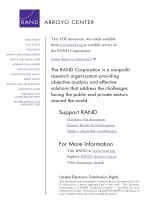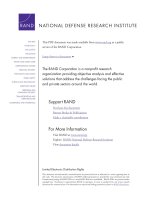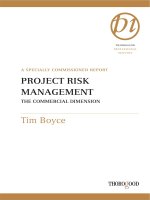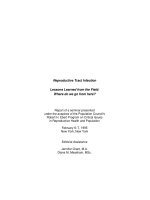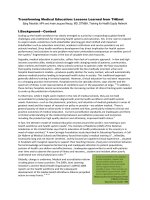Project risk management: lessons learned from software development environment pdf
Bạn đang xem bản rút gọn của tài liệu. Xem và tải ngay bản đầy đủ của tài liệu tại đây (131.93 KB, 6 trang )
Technovation 24 (2004) 915–920
www.elsevier.com/locate/technovation
Project risk management: lessons learned from software
development environment
Y.H. Kwak
a,∗
, J. Stoddard
b
a
Project Management Program, Department of Management Science, Monroe Hall 403, School of Business and Public Management, The
George Washington University, Washington, DC 20052, USA
b
Agilent Technologies, 2679 Monument Drive, Santa Rosa, CA 95407, USA
Abstract
The challenges and realities in applying effective software risk management processes are difficult, in particular integrating the
risk management processes into software development organizations. However, the benefits of implementing effective risk manage-
ment tools and techniques in software development project are equally great. Current perceptions and emerging trends of various
software risk management practices are reviewed and risks specific to software development projects are identified. Implementing
effective risk management process will succeed by changing the organizational culture. This paper addresses lessons learned from
implementing project risk management practices in software development environment.
2003 Elsevier Science Ltd. All rights reserved.
Keywords: Risk management; Software development; Project management; Technology management; Lessons learned; Organization
1. Software project environment
Project failures are the result of the multiplicity of
risks inherent in software project environment. Software
development projects are collections of larger programs
with many interactions and dependencies. It involves a
creation of something that has never been done before
although the development processes are similar among
other projects. As a result, software development pro-
jects have a dismal track-record of cost and schedule
overruns and quality and usability problems. Jiang and
Klein (1999) find different types of risks will affect
budget, user satisfactions, and system performance.
Other studies indicate that 15 to 35% of all software
projects are cancelled outright, and the remaining pro-
jects suffer from schedule slippage, cost overruns, or
failure to meet their project goals (Boehm, 1991)
(Klein, 1998).
Time-to-market is the most critical factor for con-
sumer in developing commercial software products.
However the project success is difficult to predict
∗
Corresponding author. Tel.: +1-202-994-7115; fax: +1-202-994-
2736.
E-mail address: (Y.H. Kwak).
0166-4972/03/$ - see front matter 2003 Elsevier Science Ltd. All rights reserved.
doi:10.1016/S0166-4972(03)00033-6
because project scope is changed by continuous market
requirements and resources are constantly being reallo-
cated to accommodate latest market conditions. Projects
for specific customers also have a large degree of uncer-
tainty for requirements due to the customized technical
attributes. As a result, software development engineers
have high turnover rates among software development
firms. For example, software managers in India per-
ceived personnel turnover as their biggest source of risk
(Boehm and DeMarco, 1997).
Many software projects and programs involve mul-
tiple entities such as companies, divisions, etc., that may
have certain interests. There is often a feeling of discon-
nection between software developers and their manage-
ment, each believing that the others are out of touch with
reality resulting in misunderstanding and lack of trust.
Research shows that 45% of all the causes of delayed
software deliverables are related to organizational issues
(van Genuchten, 1991).
2. Software risks and risk management perceptions
Current perceptions about risk management from
majority of software project organizations contributes to
the lack of project stability in addition to the inherent
916 Y.H. Kwak, J. Stoddard / Technovation 24 (2004) 915–920
challenges posed by the nature of software projects.
Kwak and Ibbs (2000) identified risk management as the
least practiced discipline among different project man-
agement knowledge areas. Boehm and DeMarco (1997)
mentioned that “our culture has evolved such that own-
ing up to risks is often confused with defeatism”.In
many organizations, the tendency to ‘shoot the messen-
ger’ often discourages people from bringing imminent
problems to the attention of management. This attitude
is the result of a misunderstanding of risk management.
Boehm (1991) identified 10 software risk items to be
addressed by software development projects:
ț Personnel shortfalls
ț Unrealistic schedules and budgets
ț Developing the wrong functions and properties
ț Developing the wrong user interface
ț Gold plating (adding more functionality/features than
is necessary)
ț Continuing stream of requirements changes
ț Shortfalls in externally furnished components
ț Shortfalls in externally performed tasks
ț Real-time performance shortfalls
ț Straining computer-science capabilities.
Jones (1998) further presented three key software risk
factors and concerns of both executives and software
managers.
ț Risks associated with inaccurate estimating and
schedule planning
ț Risks associated with incorrect and optimistic status
reporting
ț Risks associated with external pressures, which dam-
age software projects.
However, most software developers and project man-
agers perceive risk management processes and activities
as extra work and expense. Risk management processes
are the first thing to be removed from the project activi-
ties when the project schedule slips. The free-spirited
culture in many software development firms is in conflict
with the amount of control often required to develop
complex software systems in a disciplined way. Jones
(2001) mentioned “it is a peculiarity of IT that very com-
plex systems can be built with a very low level of control
by clever, driven people”. Many software development
practitioners understand risk management and control as
inhibiting creativity.
3. Various software development risk management
processes
Despite the inherent risks associated with software
development projects, there are strong indicators that
these risks can be managed successfully. Research of
failed software projects showed that “their problems
could have been avoided or strongly reduced if there had
been an explicit early concern with identifying and
resolving their high-risk elements” (Boehm, 1991).
Effective risk management is the most important man-
agement tool a project manger can employ to increase
the likelihood of project success. Since risk management
is not widely used and understood, this could be a sig-
nificant competitive advantage to those that implement
the risk management processes in their projects.
A large number of processes have been generated in
recent years to address the need for more effective risk
management. The risk management process provided in
the PMBOK (PMI, 2001) is a good overview of the
typical processes, yet it is often too generic to meet the
specific needs of software projects. The Software Engin-
eering Institute (SEI) has developed the Team Software
Process (TSP) for the team as a whole, and the Per-
sonal Software Process (PSP) for the individual dur-
ing software project development (SEI, 2001). Keshlaf
and Hashim (2000) have developed models for tools to
aid the software risk management process. As shown in
Fig. 1, it uses an eight-step process during the initial
phases of the project. When any new risks are identified
throughout the project, a five-step inner process is used
to improve earlier estimates and judgments continuously.
‘Team risk management’ is a process that addresses
the risks associated with multiple entities (Higuera et al.,
1994). Although developed specifically for software con-
tractual relationships, the concept is just as viable for
multiple divisions or multiple projects, which is a com-
mon paradigm in most organizations. Table 1 shows the
principles involved with team risk management and the
requirements for effective risk management in the pro-
cess.
The ‘team reviews’ section is the principal process
that makes the team process unique from other general
Fig. 1. ‘Soft Risk’ model’s diagram (adapted from Keshlaf and
Hashim (2000)).
917Y.H. Kwak, J. Stoddard / Technovation 24 (2004) 915–920
Table 1
Nine principles of team risk management (adapted from Higuera et al. (1994))
Principle Effective risk management
Shared product vision A shared vision for success based upon commonality of purpose, shared ownership, and collective
commitment.
Forward-looking search for Thinking toward tomorrow, anticipating potential outcomes, identifying uncertainties, and managing
uncertainties program resources and activities while recognizing these uncertainties.
Open communications A free flow of information at and between all program levels though formal, informal, and impromptu
communication and consensus-based processes.
Value of individual perception The individual voice, which can bring unique knowledge and insight to the identification and management
of risk.
Systems perspective That software development is viewed within the larger systems-level definition, design, and development.
Integration into program That risk management is an integral and vital part of program management.
management
Proactive strategies Proactive strategies that involve planning and executing program activities based on anticipating future
events.
Systematic and adaptable A systematic approach that is adaptable to the program’s infrastructure and culture.
methodology
Outline and continuous processes A continuous vigilance characterized by routine risk identification and management activities throughout all
phases of the life cycle of the program.
processes. The objective of team risk management is to
share the risk responsibility and burden to effectively
lower the risk of all entities involved. Fig. 2 shows the
interaction of the team risk management processes
(Higuera et al., 1994).
Yacoub and Ammar (2002) described a heuristic risk
assessment methodology that uses dynamic metrics
obtained from Unified Modeling Language (UML)
specifications to determine the most risky components
of the software architecture. It is mathematical analysis
models derived from the UML diagram, and enables
more attention to be placed in the areas of the system
with highest risk.
Even the simplest mathematical models contain at
least a rating scheme allows managers to quantify and
prioritize the risks during the process. A concept used
by many of these rating schemes is risk exposure
Fig. 2. Concurrent team risk management process (adapted from Higuera et al. (1994)).
(Risk exposure = Probability (Loss) × Size (Loss)).
Boehm and DeMarco (1997) showed that the probability
component of risk exposure for employee turnover (one
of the highest risk elements of most software projects)
can be reduced by:
ț Empowering performers
ț Teambuilding
ț Establishing significant incentive bonuses for success-
ful project completion
ț Recognizing outstanding efforts
ț Structuring career paths around an organizations pro-
duct lines.
Furthermore, the size component of risk exposure can
be reduced by:
ț Implementing software inspections to reduce defects
918 Y.H. Kwak, J. Stoddard / Technovation 24 (2004) 915–920
and spread knowledge of product components among
various people
ț Using egoless programming
ț Clean room techniques
ț Modular software architectures
ț Encapsulation
ț Good configuration management.
Although the foregoing strategies help to overcome
the risk exposure to many risks in developing software,
this is simply called good programming. Good program-
ming methods reduce risk as well as have a positive
affect on other project facets such as development time,
team morale, and product quality.
4. Practical implementation and its results
The major obstacle to overcome regarding people is
human nature, which encompasses many facets. Jiang et
al. (2001) proposed a model that relates sources of risk
to strategies and success. The result indicated that stra-
tegies involving behavioral aspects tend to be more
influential in risk reduction than are those aimed at tech-
nical risks. Jiang et al. (2000) further revealed that effec-
tive project teams reduce technical risks involved in sys-
tem development. Schmidt et al. (2001) developed an
authoritative list of common risk factors and deployed a
rigorous data collection method called a ‘ranking-type’
Delphi survey to produce a rank-order list of risk factors.
The practical implementation of the foregoing pro-
cesses is one of the most challenging aspects of risk
management. Conrow (2000) observed that “one of the
biggest problems with many risk management processes
is that one or more process steps is either missing,
weakly implemented, or out of order”. Conrow’s assess-
ment is meaningful; however, it is not very helpful until
the root causes are identified for these results. It is help-
ful to identify the fundamental elements of any software
project which are people, and their environment in find-
ing the root causes.
4.1. Process vs. project obstacle
First, it is important to understand the differences
between project and process. Table 2 compares between
project and process management. Project risk manage-
ment must be a natural part of the software development
process to be most effective. Hall (1998) noted that,
“There is no ‘risk season’ or a separate team to perform
risk management. Risk management is integrated by dis-
tribution into routine project activities”. Each team
member must use the risk management process as a tool
during project execution although a project itself is not
a process. Ideally, project team members will be able to
adapt risk management practices to their particular pro-
Table 2
Comparison between project management and process management
Project management Process management
Project has fixed duration Processes are continuous and
endless
Resources are allocated to the Resources are allocated to
project functional group
Performance is measured for Performance is measured by
the project operation
Project is one of a kind, and Work is replicated and repeated
unique
ject environment if team members are well trained.
Recent literatures emphasize the importance of educat-
ing risk management tools and techniques to software
development community (Boehm and Port, 2001; Fuller
et al., 2002). Project team members will benefit by learn-
ing and practicing their risk management skills to
execute their project activities.
4.2. Human nature obstacle
Project team members may have the necessary skills
to employ a risk management process; however, this
does not guarantee that the team will use it during the
project lifecycle. Gemmer (1997) described “Effective
risk management requires obtaining functional behavior
(as opposed to dysfunctional behavior), not just follow-
ing a process or having diverse sources of information.”
Furthermore, he observed “behavior is due primarily to
the organization’s history, structure, processes, and
reward system.” Table 3 shows the difference between
observed behavior and the ideal behavioral goal. For
example, the natural tendency of software developers is
to withhold technical information since information is a
source of power. However, if these developers are
rewarded and held accountable for sharing knowledge,
then this tendency can be overcome.
4.3. The magnitude of the challenge
Even in organizations with the best processes, skills,
and organizations that motivate team members towards
effective risk management, the uncertainties resulting
from the sheer magnitude of software project com-
plexities can make managing risk a daunting task,
because of the imperfections of human judgment. Hall
(2001) noted that “In all these procedures and processes,
there stands out one major source of error—the subjec-
tive nature of the risk assessments and assigning of prob-
ability of occurrence to specific risks within a program
or project”. Hall (2001) proposed a cyclic monitoring
process to obtain better assessment accuracy throughout
the project. Repetitive, continuous improvement is criti-
cal to achieving long-term success in managing risk.
919Y.H. Kwak, J. Stoddard / Technovation 24 (2004) 915–920
Table 3
Cultural norms (dysfunctional) vs. effective risk management behavior (adapted from Gemmer (1997))
Dysfunctional behavior (observed) Functional behavior (goal)
View each person’s decision-making capability as invariant Manage risk as an asset
View uncertainty as a negative Treat decision making as a skill
Don’t ask for risk information Create a pull for risk information
Don’t bring forward risks or problems without solutions Seek diversity in perspectives and information sources
Ignore the soft stuff Minimize uncertainty in time, control, and information
Be risk averse Recognize and minimize bias in perceiving risk
Make decisions based on emotion, rather than logic Plan for multiple futures
Make commitments without determining the probability of success Be proactive
Be reactive Make timely, well-informed decisions and commitments
Reward heroes Reward those who identify and manage risks early, even if the risks
become problems
Effective risk management practices in software
environments are not developed instantly. A collabor-
ative development effort between the Department of
Defense, an external contractor, and the Software Engin-
eering Institute (SEI) to transition SEI’s Team Risk
Management process into practice showed that the initial
transition period spanned more than 18 months (Gluch
et al., 1996). In most cases it will take even longer to
develop a culture that embraces effective risk manage-
ment.
5. Lessons learned
Roberts (2001) suggested the following lessons
learned for project risk management.
ț The greatest risk driver is often overlooked.
ț Inappropriate attention may be given to one risk
driver over others.
ț Often a risk driver will impact all facets of risk (cost,
schedule, technical, etc.) and the integrated result will
be improperly estimated.
ț Often risks are managed by lists which are ranked by
subjective qualitative measures resulting in excessive
expenditure of risk management resources.
ț Often risks are managed by lists which are ranked by
subjective qualitative measures resulting in excessive
expenditure of risk management resources.
ț Risk identification is the most critical step in risk
management, yet often is poorly done.
ț ‘Faster, better, cheaper’, as well as any other competi-
tive initiative, exacerbates risk.
ț All projects must include sufficient resources in the
project’s planning activity to adequately provide for
training in the risk management process.
ț A strong position must be taken by project manage-
ment to enforce participation in the process.
ț Validation of the tools and input data needs to be done
early in the life cycle of the projects. The project man-
ager needs to conduct this validation.
ț Expect the risk management process to evolve with
the project and its ever-maturing needs.
ț The indirect benefits of integrated, quantitative risk
analysis due to the demand for quality project man-
agement data are as valuable as the direct benefits.
The authors suggest the followings as lessons learned
for implementing project risk management tools and
practices to software development projects.
ț A project manager does not always have the time to
implement a formal process into the system. The pro-
ject manager must be able to train team members ‘on
the fly’ when the need arises.
ț This is where a project management can add value
to a project. Anyone can pay lots of money to hire
consultants and take training classes, but usually only
bureaucratic institutions like the federal government
can afford it.
ț Senior management holds the key to establishing an
organization that encourages ‘functional’ risk man-
agement behavior.
ț A documented process does not guarantee the process
will be followed.
ț As the size and complexity of the project increases,
the effort for risk management increase exponentially.
ț During project ‘crunch time’, the tendency is to focus
solely on short-term objectives while neglecting long-
term risks. These actions cause problems and cost
more than anticipated and put the organization into a
reactive mode that is difficult to reverse.
ț People must be able to evaluate themselves and be
motivated to act on their evaluations to change their
behaviors.
ț Real changes must occur in both management of the
organization and behavior of individuals before risk
management will improve. There are often ‘feel good’
920 Y.H. Kwak, J. Stoddard / Technovation 24 (2004) 915–920
exercises where project evaluations or retrospectives
are made, but no real changes occur.
ț The people that are actually doing the development
work on the project team must be empowered as well
as have knowledge and motivation to change prac-
tices. Throwing a manager or a ‘focus group’ at a
problem is not effective in solving the issues of poor
risk management practices, unless they are empow-
ered to affect organizational changes and train project
team members in better risk practices.
6. Conclusions
Although software risk management is a daunting
task, organizations that implement effective processes
proved to be successful, while those that fail in this effort
will be unsuccessful. The nature of software projects cre-
ates many risks that must be managed diligently to avoid
the common drawback of many projects. The percep-
tions and attitudes towards risk management activities
compound difficult challenges for implementing a risk
management strategy.
Formal risk management process is recommended to
manage complex issues associated with software devel-
opment projects. Many risk management processes have
been created to aid organizations, but integrating the pro-
cesses into organizations was not successful. The theor-
etical aspects of the process must be reconciled with the
practical challenges of the organization to implement
risk management successfully. Effective risk manage-
ment process will succeed by changing the organiza-
tional culture to motivate the individual. Cultural
changes require time and repetition before they are
firmly embedded into the organization.
References
Boehm, B.W., 1991. Software risk management principles and prac-
tices. IEEE Software 8 (1), 32–41.
Boehm, B.W., DeMarco, T., 1997. Software risk management. IEEE
Software 14 (3), 17–19.
Boehm, B., Port, D., 2001. Educating software engineering students
to manage risk. In: Proceedings of the 23rd International Confer-
ence on Software Engineering,, pp. 591–600.
Conrow, E.H., 2000. Effective risk management: some keys to success.
American Institute of Aeronautics and Astronautics.
Fuller, A., Croll, P., Di, L., 2002. A new approach to teaching software
risk management with case studies. In: Proceedings of the 15th
conference on Software Engineering Education and Training,, pp.
215–222.
Gemmer, A., 1997. Risk management: moving beyond process. Com-
puter 30 (5), 33–43.
Gluch, D.P., Dorofee, A.J., Hubard, E.A., Travalent, J.J., 1996. A col-
laboration in implementing team risk management. In: Technical
Report, CMU/SEI-95-TR-016. Software Engineering Institute.
Hall, D.C., 2001. Development program risk management: a case
study. In: 2001 INCOSE Proceedings of a Symposium on Risk
Management,, 3.
Hall, E.M., 1998. Managing Risk: Methods for Software Systems
Development. Addison-Wesley.
Higuera, R.P., Gluch, D.P., Dorofee, A.J., Murphy, R.L., Walker, J.A.,
Williams, R.C., 1994. An introduction to team risk management.
In: Special Report, CMU/SEI-94-SR-1. Software Engineering Insti-
tute.
Jiang, J.J., Klein, G., 1999. Risks to different aspects of system suc-
cess. Information and Management 36 (5), 263–272.
Jiang, J.J., Klein, G., Discenza, R., 2001. Information system success
as impacted by risks and development strategies. IEEE Trans-
actions on Engineering Management 48 (1), 46–55.
Jiang, J.J., Klein, G., Means, T.L., 2000. Project risk impact on
software development team performance. Project Management
Journal 31 (4), 19–26.
Jones, C., 1998. Minimizing the risks of software development. Cutter
IT Journal 11 (6), 13–21.
Jones, G.F., 2001. What is different about it risks. In: 2001 INCOSE
Proceedings of a Symposium on Risk Management,, 3.
Keshlaf, A.A., Hashim, K., 2000. A model and prototype tool to man-
age software risks. In: Proceedings of First Asia–Pacific Confer-
ence on Quality Software,, pp. 297–305.
Klein, S.A., 1998. Putting methodology in perspective from a project
risk viewpoint. In: IEEE Power Engineering Society 1999 Winter
Meeting, vol. 1,, pp. 362–365.
Kwak, Y.H., Ibbs, C.W., 2000. Calculating project management’s
return on investment. Project Management Journal 31 (2), 38–47.
PMI, 2001. A Guide to the Project Management Body of Knowledge
(PMBOK Guide) 2000 Edition, Project Management Institute
Publications.
Roberts, B.B., 2001. Lessons-learned: round 2. In: 2001 INCOSE Pro-
ceedings of a Symposium on Risk Management,, 3.
Schmidt, R., Lyytinen, K., Keil, M., Cule, P., 2001. Identifying
software project risks: an international Delphi study. Journal of
Management Information Systems 17 (4), 5–36.
SEI, 2001. Carnegie Mellon SEI Annual Report FY2001.
van Genuchten, M., 1991. Why is software late? An empirical study
of reasons for delay in software development. IEEE Transactions
on Software Engineering 17 (6), 582–590.
Yacoub, S.M., Ammar, H.H., 2002. A methodology for architecture-
level reliability risk analysis. IEEE Transactions on Software
Engineering 28 (6), 529–547.
Young Hoon Kwak is currently assistant professor of project management
at the management science department at The George Washington Univer-
sity (GWU). He has received his M.S. and Ph.D. in engineering and pro-
ject management at the University of California at Berkeley. Before join-
ing GWU, he has spent a year at MIT as a post-doctoral scholar.Dr. Kwak
has numerous publications in both academic and practitioner journals
related to project management, risk management, and technology manage-
ment. He has also consulted for Fortune 500 companies for assessing the
maturity level of project management. For more information, visit his
homepage at />Jared Stoddard is currently product manager for consumer and wireless
solutions test division at Agilent Technologies. He received his B.S. in
Electrical Engineering from Brigham Young University and M.S. in Pro-
ject Management from The George Washington University. Jared has writ-
ten and presented various technical papers in wireless semiconductor test
technology. His most recent research effort has been is in the area of
‘product generation excellence’ at Agilent, including the project manage-
ment of both software and hardware systems development.

